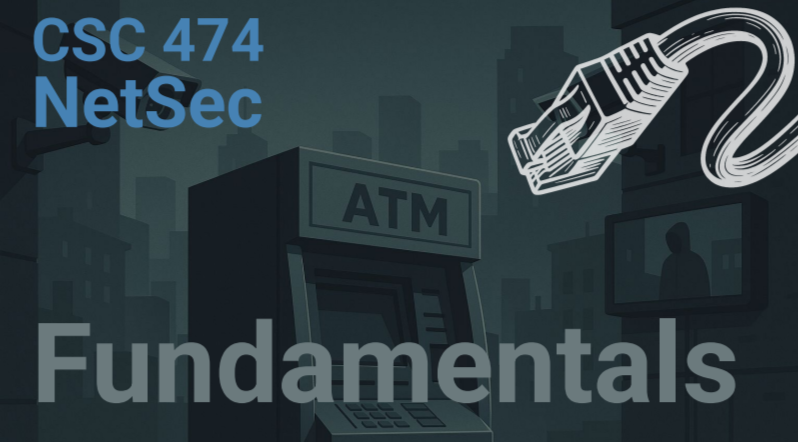CSC 474
Network Security
Level:
[Undergrad]
Number:
CSC 474
Title:
Network Security
Format:
In-person, recorded lectures
Credits:
3
Offerings:
2025 Spring, 2025 Fall
Introductory computer security course for undergraduate students covering network attacks and vulnerabilities as well as current defenses. Topics covered include cryptography, authentication protocols, VPNs & firewalls, routing and DNS security, and anonymity
Rotating Instructors: Note that this course is taught by a rotating set of instructors depending on availability. This course page reflects my offering of the course. Structure and content may vary between instructors.
Overview #
This introductory course will impart a broad understanding of the underpinnings of security techniques, security best practices, and security failures. Coverage of high-level concepts such as confidentiality, integrity, and availability applied to hardware, software, and data.
The course should help students to understand the mindsets of attackers (the bad guys and gals who do malicious things on the network) and system designers and defenders (the good guys and gals who try to stop the attackers). The course should prepare students to understand and assess security threats, become familiar with security engineering best practices, and write better software, protocols, and systems.
Topics #

Security Fundamentals
Intro to key security concepts and principles like terminology, CIA triad, and security modeling.

Intro to Cryptography
Intro to basic cryptographic concepts including symmetric and asymmetric encryption, hashing, and digital signatures.

Network Security
Overview of network security principles, protocols, and practices, including routing, TLS, Wi-Fi security, and VPNs.

Web Security
Overview of web security on the client and server side, including common vulnerabilities like XSS, CSRF, and SQL injection.

Anonymity
Exploration of anonymity concepts and tools, including Tor, VPNs, and privacy-enhancing technologies.
Topic List #
- Course Introduction: Course introduction, syllabus, activity waiver
- Security Fundamentals: Security terminology, security models
- Intro to Cryptography: Crypto terms, cryptographic systems
- Symmetric Cryptography: Stream ciphers, block ciphers, modes of operation
- Hashes and MACs 1: Cryptographic hash functions, message authentication codes
- Hashes and MACs 2: Message authentication, other hash uses
- Asymmetric Cryptography: Asymmetric crypto, RSA, digital signatures
- Key Management: Diffie Hellman, key exchange, PKI
- User Authentication: Credentials, passwords, multi factor authentication
- Authentication Protocols 1: Cookies, mutual authentication
- Authentication Protocols 2: Mediated authentication, Kerberos, federated identity, OAuth
- Transport Layer Security: TLS handshake, session resumption, attacks
- Network Background and TCP IP Attacks: Network layers, TCP IP attacks
- Malware: Malware, ransomware, malware defenses, detection
- Firewalls and Tunnels: Firewalls, VPNs, tunnels
- Intrusion Detection Systems: IDS, confusion matrix, ROC curve
- Routing Security: Routing, routing attacks, BGP attacks, BGPSEC, RPKI
- DNS Security: DNS, DNS attacks, cache poisoning, SAD DNS, DNSsec
- Wireless Security: WEP, WPA, WPA2, WPA3, KRACK attack, EAP
- Cloud Security: Public clouds, private clouds, virtualized execution, cloud security
- Web Security: URI, JavaScript, same origin policy, CORS, CSRF, XSS
- Anonymity: Internet anonymity, dining cryptographer problem, overlay networks, anonymity strength, proxies, VPNs, Crowds, Tor
- AI and Network Security: AI in networking security contexts